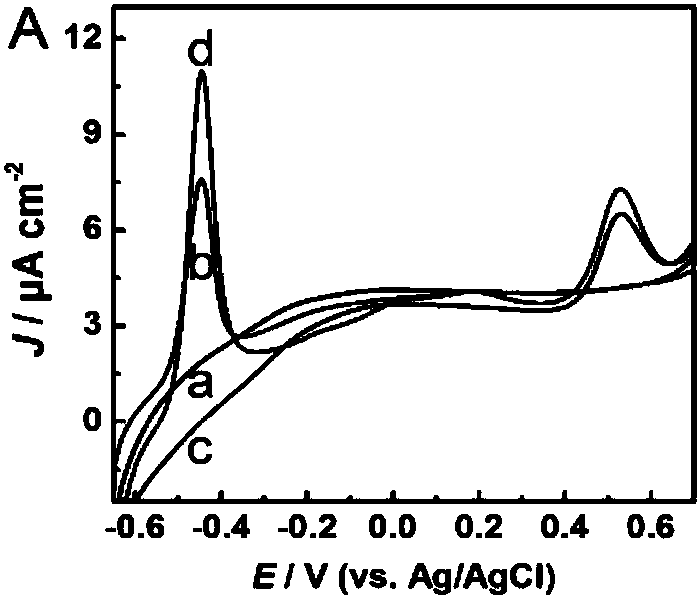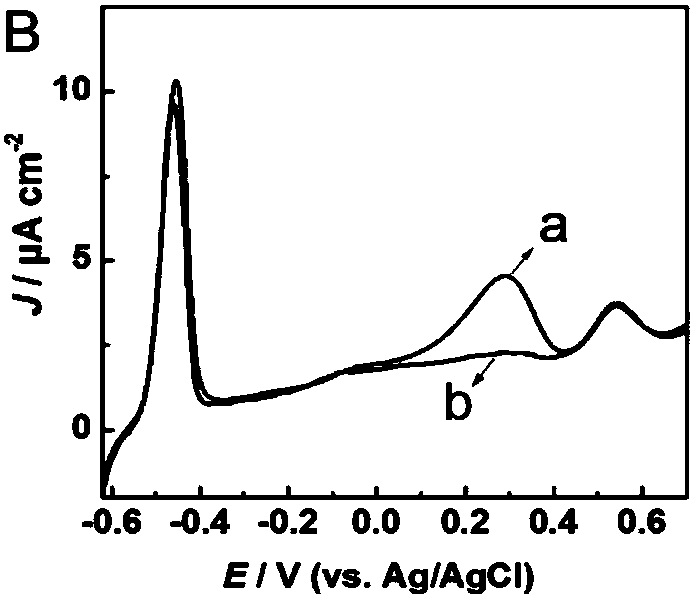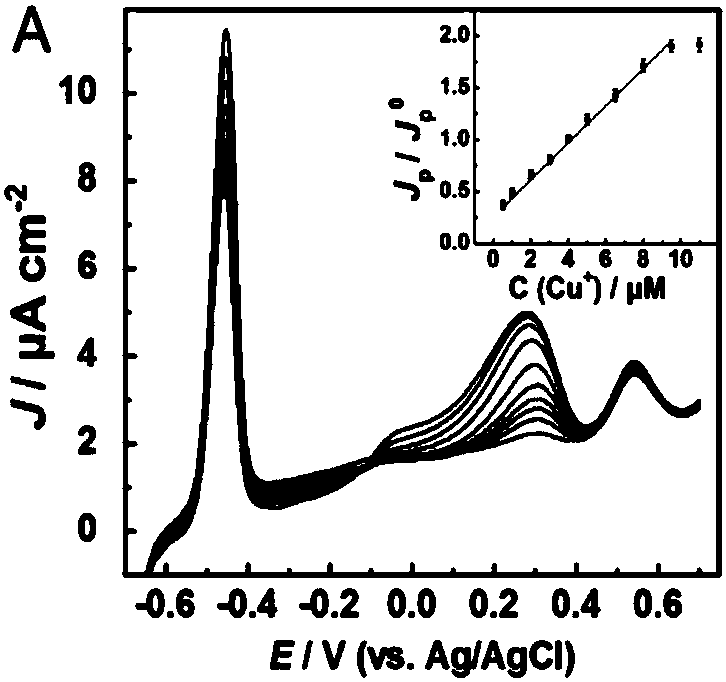Carbon nano material modified electrode capable of simultaneously detecting Cu+ and pH and preparation method
A carbon nanomaterial and electrode modification technology, applied in the field of analysis, can solve problems such as no electrochemical method, and achieve the effects of real-time online electrochemical detection, feasible analysis method and low cost
- Summary
- Abstract
- Description
- Claims
- Application Information
AI Technical Summary
Problems solved by technology
Method used
Image
Examples
Embodiment 1
[0036] Utilize CHI660 electrochemical workstation to carry out linear voltammetry scanning to the carbon nanomaterial modified electrode prepared in embodiment 1, scanning speed: 0.05V / s, such as figure 1 Shown; where, a is the linear scanning oxidation curve of bare carbon nanomaterials (bare carbon fiber electrodes) in artificial cerebrospinal fluid, b is the linear scanning oxidation curve of electrodes modified by pH-responsive molecule 1.2-anthraquinone molecules in artificial cerebrospinal fluid, c is the linear scanning oxidation curve of the reference molecule ABTS modified electrode in artificial cerebrospinal fluid, d is the pH response molecule 1,2-anthraquinone, Cu + Recognition ligand (in formula I, R is ) Linear scanning oxidation curves of electrodes co-modified with C and reference molecule ABTS in artificial cerebrospinal fluid. Among them, bare carbon nanomaterials only have charging background current ( figure 1 a). The linear scan oxidation curve of the...
Embodiment 2
[0038] Utilize CHI660 electrochemical workstation to carry out linear voltammetry scanning to the carbon nanomaterial modified electrode prepared in embodiment 1, scanning speed: 0.05V / s, experimental result is as follows figure 2 As shown, curve a is the artificial cerebrospinal fluid added 5μM Cu + The linear scanning curve of the post-carbon nanomaterial modified electrode shows that an oxidation peak appears around 0.3V, and is well separated from the oxidation peak signals of pH-responsive molecules and reference molecules. Curve b is the linear sweep voltammetry curve of the carbon nanomaterial modified electrode after adding 20 μM alkaline EDTA on the basis of a. It can be clearly seen that after adding EDTA to the artificial cerebrospinal fluid, Cu at 0.3V + The oxidation peak of the disappearance, proving that the complexing force of EDTA is stronger than that of selective Cu + Recognition ligand (in formula (I), R group is ), Cu + Released again from the electro...
Embodiment 3
[0040] Utilize CHI660 electrochemical workstation to carry out monovalent copper ion Cu to the carbon nanomaterial modified electrode prepared in embodiment 1 + Titration experiment, and then sequentially carry out linear voltammetry scanning, scanning speed: 0.05V / s, the experimental results are as follows image 3 As shown, the carbon nanomaterial modified electrode is for Cu + There are good responses. Cu trapped on the electrode surface by the recognized ligand + There is an oxidation peak at 0.3V, and the peak current density of the oxidation peak gradually increases with the increase of copper ion concentration, and shows good linearity in the range of 0.5 μM to 11.0 μM. At the same time as the measurement, the signals of the pH probe molecule and the reference molecule are stable and will not interfere with the detection of copper ions.
PUM
| Property | Measurement | Unit |
|---|---|---|
| diameter | aaaaa | aaaaa |
| pore size | aaaaa | aaaaa |
Abstract
Description
Claims
Application Information
 Login to View More
Login to View More - R&D
- Intellectual Property
- Life Sciences
- Materials
- Tech Scout
- Unparalleled Data Quality
- Higher Quality Content
- 60% Fewer Hallucinations
Browse by: Latest US Patents, China's latest patents, Technical Efficacy Thesaurus, Application Domain, Technology Topic, Popular Technical Reports.
© 2025 PatSnap. All rights reserved.Legal|Privacy policy|Modern Slavery Act Transparency Statement|Sitemap|About US| Contact US: help@patsnap.com



